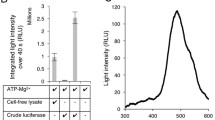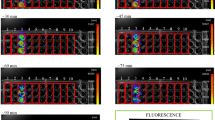Abstract
The enzymes for luminescence inVibrio fischeri are induced only when a sufficient concentration of a metabolic product (autoinducer) specifically produced by this species accumulates. It has previously been shown that the autoinducer is 3-oxohexanoyl homoserine lactone and that it enters the cells by simple diffusion. To further study the mechanism of induction, we have synthesized several analogs of the autoinducer. The analogs were tested withV. fischeri for their inducing activity and for their ability to inhibit the action of the natural autoinducer. The compounds were found to display various combinations of inducing and inhibiting abilities. None of the compounds tested appeared to have any effect on cells ofV. harveyi strain MAV orPhotobacterium leiognathi strain 721, but several of the compounds decreased light output byP. phosphoreum strain 8265. These studies show that 1) the site of action of the autoinducer is not highly sterically constrained 2) the autoinducers of other species of luminous bacteria are likely to be quite different from that ofV. fischeri and 3) a simple mode in which one autoinducer molecule binds to a single receptor protein site and thus initiates luciferase synthesis is inadequate. The analogs should prove useful in the study of the binding site and mode of action of the autoinducer.
Similar content being viewed by others
Abbreviations
- SWC:
-
sea water complete
References
Eberhard A (1972) Inhibition and activation of bacterial luciferase synthesis. J. Bacteriol 109:1101–1105
Eberhard A, Burlingame AL, Eberhard C, Kenyon GL, Nealson KH, Oppenheimer NJ (1981) Structural identification of autoinducer ofPhotobacterium fischeri luciferase. Biochemistry 20:2444–2449
Engebrecht J, Silverman M (1984) Identification of genes and gene products necessary for bacterial bioluminescence. Proc Natl Acad Sci USA 81:4154–4158
Hastings JW, Weber G (1963) Total quantum flux of isotropic sources. J Opt Soc Amer 53:1410–1415
Kaplan HB, Greenberg EP (1985) Diffusion of autoinducer is involved in regulation of theVibrio fischeri luminescence system. J Bacteriol 163:1210–1214
Kaplan HB, Eberhard A, Widrig C, Greenberg EP (1985) Synthesis of N-[3-oxo-(4,5-3H2)-hexanoyl] homoserine lactone: Biologically active tritium-labelledVibrio fischeri autoinducer. J Labelled Cmpds Radiopharm 22:387–395
Khokhlov AS (1982) Low molecular weight microbial bioregulators of secondary metabolism. In: Krumphanzl V, Sikyta B, Vanek Z (eds) Overproduction of microbial products. Academic Press, New York, pp 97–109
Mitchell GW, Hastings JW (1971) A stable, inexpensive solid-state photomultiplier photometer. Anal Biochem 39:243–250
Nealson KH (1977) Autoinduction of bacterial luciferase: Occurrence, mechanism and significance. Arch Microbiol 112:73–79
Wierenga W, Skulnick HI (1979) General, efficient, one-step synthesis of β-keto esters. J Org Chem 44:310–311
Author information
Authors and Affiliations
Rights and permissions
About this article
Cite this article
Eberhard, A., Widrig, C.A., McBath, P. et al. Analogs of the autoinducer of bioluminescence inVibrio fischer . Arch. Microbiol. 146, 35–40 (1986). https://doi.org/10.1007/BF00690155
Received:
Accepted:
Issue Date:
DOI: https://doi.org/10.1007/BF00690155




